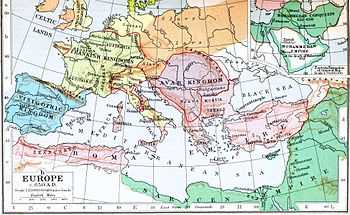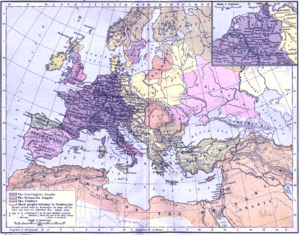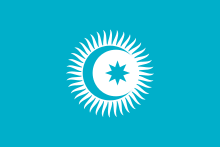Avar Khaganate
| Avar Khaganate | |||||
| |||||
 | |||||
| Capital | Not specified | ||||
| Languages | Avar Turkic, Pannonian Romance, Slavic dialects | ||||
| Religion | Tengriism | ||||
| Government | Khanate | ||||
| Khagan | |||||
| - | 562-602 | Bayan I | |||
| History | |||||
| - | Established | 567 | |||
| - | Disestablished | c. 804 | |||
The Avar Khaganate was a khanate established in the Pannonian Basin region in 567 by the Avars. It was a confederacy ruled by a group of medieval equestrian warrior nomads of Altaic-[4]Turkic[5][6] extraction known as Avars or Pseudo-Avars, and which included Slavs and other Pontic–Caspian steppe tribes. As the Göktürk Empire expanded westwards, the Khagan Bayan I led a group of Avars and Bulgars out of their reach, eventually settling around 568 in what used to be the Roman province of Pannonia.
History
Arrival in Europe

In 557, the Avars sent an embassy to Constantinople, marking their first contact with the Byzantine Empire—presumably from the northern Caucasus. In exchange for gold, they agreed to subjugate the "unruly gentes" on behalf of the Byzantines. They conquered and incorporated various nomadic tribes—Kutrigur Bulgars, Onogur or Utigur Bulgars, and Sabirs—and defeated the Antes. By 562, the Avars controlled the lower Danube basin and the steppes north of the Black Sea.[7] By the time they arrived in the Balkans, the Avars formed a heterogeneous group of about 20,000 horsemen.[8] After the Byzantine Emperor Justinian I bought them off, they pushed northwestwards into Germania. However, Frankish opposition halted the Avars' expansion in that direction.
Seeking rich pastoral lands, the Avars initially demanded land south of the Danube River in present-day Bulgaria, but the Byzantines refused, using their contacts with the Göktürks as a threat against Avar aggression.[9] They turned their attention to the Carpathian plain and to the natural defenses it afforded.[10] However, the Carpathian basin was then occupied by the Gepids. In 567, the Avars signed an alliance with the Lombards—enemies of the Gepids—and together they destroyed much of the Gepid Kingdom. The Avars then persuaded the Lombards to move into northern Italy, an invasion that marked the last Germanic mass-movement in the Migration Period.
Continuing their successful policy of turning the various barbarians against each other, the Byzantines persuaded the Avars to attack the Sclavenes in Scythia Minor; their land was rich with goods and had never been conquered before.[11] After devastating much of the Sclavenes' land, the Avars returned to Pannonia after many of the Khagan's subjects deserted to the Byzantine Emperor. By 600, the Avars had established a nomadic empire ruling over a multitude of peoples and stretching from modern-day Austria in the west to the Pontic-Caspian steppe in the east.
Early Avar Period (580-670)

By about 580, the Avar Khagan Bayan I had established supremacy over most of Slavic, Hunno-Bulgar, and Germanic tribes living in Pannonia and the Carpathian Basin.[12] When the Byzantine Empire was unable to pay subsidies or hire Avar mercenaries, the Avars raided their Balkan territories. According to Menander, Bayan commanded an army of 10,000 Kutrigur Bulgars and sacked Dalmatia in 568, effectively cutting the Byzantine terrestrial link with North Italy and Western Europe. By 582, the Avars had captured Sirmium, an important fort in Pannonia. When the Byzantines refused to increase the stipend amount as requested by Bayan's son and successor Bayan II (from 584), the Avars proceeded to capture Singidunum and Viminacium. They suffered setbacks, however, during Maurice's Balkan campaigns in the 590s. After being defeated in their homeland, some Avars defected to the Byzantines in 602,[13] but Emperor Maurice decided not to return home as was customary. He maintained his army camp beyond the Danube throughout the winter and the resulting hardships caused the army to revolt. This gave the Avars a desperately needed respite. The ensuing civil war prompted a Persian invasion and after 615, the Avars enjoyed a free hand in the undefended Balkans. They attempted an invasion of northern Italy in 610. While negotiating with Emperor Heraclius beneath the walls of Constantinople, the Avars launched a surprise attack, pillaged the suburbs of the city and took 270,000 captives. They were, however, unable to capture the city in 617. Payments in gold and goods reached the record sum of 200,000 solidi shortly before 626.[14]
In 626, the siege of Constantinople by a joint Avar-Sassanid force failed. Following this defeat, the prestige and power of the Avars declined. The Byzantines and Franks document a war between the Avars and their western Slav clients, the Wends.[15] In the 630s, Samo, the ruler of the first historically known Slavic polity known as Samo's Tribal Union or Samo's realm, increased his authority over lands to the north and west of the Khaganate at the expense of the Avars, ruling until his death in 658[16]
At about the time of Samo's realm, the Kubrat of the Dulo clan led a successful uprising to end Avar authority over the Pannonian Plain; he established what the Byzantines used to call Patria Onoguria, "the homeland of Onogurs" or Old Great Bulgaria. The civil war, possibly a succession struggle in Onoguria between the joint Avar/Kutrigur Bulgar parties and Kubrat's Utigur Bulgar forces, raged from 631 to 632. The power of the Avar/Kutrigur forces was shattered and the Avars came under the control of Patria Onoguria. Chronicler Fredegarius recorded that 9,000 of the Avar/Kutrigur Bulgars sought asylum and fled to modern-day Bavaria, but were killed by King Dagobert I of the Franks. Some remained in Onoguria and came to be known as Cozariks—still noted in Transylvania even as late as the time of Menumorut around 895. Following Khan Kubrat's death, they would fight for control, leading to the battle of Ongal when the Utigurs were forced south. Those remaining between Transylvania and the Ukraine were assimilated by the Khazars while the Cozariks extended their control north up the Volga River where the state of Volga Bulgaria would emerge.
Middle (670-720) and Late (720-804) Avar periods

With the death of Samo, some Slavic tribes again came under Avar rule. Khan Kubrat died in 665 and was succeeded by Khan Batbayan of Old Great Bulgaria. By 670, the Khazars had broken the unity of the Bulgar confederation, causing some of the Utigur Bulgars to relocate their capital to the west. The Viennese chronicle records that in 677, the "Hungar"/(Onogur Bulgar) ethnicon had established itself decisively in Pannonia. According to the Miracles of Saint Demetrius the Avar-Slavic alliance from northern Carpathia forced the Bulgars south out of western Onoguria (Sirmium) at about the same time that the Battle of Ongal took place south of the eastern Carpathians. The new ethnic element marked by hair clips for pigtails; curved, single-edged sabres; broad, symmetrical bows marks the middle Avar-Bulgar period (670-720). The Onogur Bulgars under a Kuber leader expelled from western Onoguria (Sirmium) moved south, settling in the present-day region of Macedonia. The Onogur/Utigur Bulgars, led by Khan Asparukh—the father of Khan Tervel—settled permanently along the Danube (c. 679-681), expanding the First Bulgarian Empire from Onogur, Bulgaria. Although the Avar empire had diminished to half its original size, the new Avar-Slav alliance consolidated their rule west from the central parts of the mid-Danubian basin and extended their sphere of influence west to the Viennese Basin. New regional centers, such as those near Ozora and Igar—county Fehér in Hungary—appeared. This strengthened the Avars' power base, although most of the Balkans now lay in the hands of Slavic tribes since neither the Avars nor Byzantines were able to reassert control.
The Khaganate in the Middle and Late periods was a product of cultural symbiosis between Slavic and original Turkic elements with a Slavic language as a lingua franca or the most common language.[17]
In the 7th century, the Avar Khaganate opened a door for Slavic demographic and linguistic expansion to Adriatic and Aegean regions.
In the early 8th century, a new archaeological culture the so-called "griffin and tendril" culture—appeared in the Carpathian basin. Some theories, including the “double conquest” theory of archaeologist Gyula László, attribute it to the arrival of new settlers, such as early Magyars, but this is still under debate. Hungarian archaeologists Laszló Makkai and András Móczy attribute this culture to an internal evolution of Avars resulting from the integration of the Bulgar émigrés from the previous generation of the 670s. According to Makkai and Mócsy, "the material culture—art, clothing, equipment, weapons—of the late Avar/Bulgar period evolved autonomously from these new foundations". Many regions that had once been important centers of the Avar empire had lost their significance while new ones arose. Although Avaric material culture found over much of the northern Balkans may indicate an existing Avar presence, it probably represents the presence of independent Slavs who had adopted Avaric customs.[18]
Collapse
The gradual decline of Avar power accelerated to a rapid fall within a decade. A series of Frankish campaigns in the 790s led by Charlemagne ended with the conquest of the Avar realm, taking most of Pannonia up to the Tisza River. Avar occupation was ended when a Slavic-Croatian force led by prince Vojnomir and supported by the Franks launched a counterattack in 791.[19][20] The offensive was successful and the Avars were driven out of Pannonian Croatia.[20] Charlemagne won another major victory against the Avars in 796.[21] One of Charlemagne's sons captured a large, fortified encampment known as "the Ring", which contained much of the spoils from earlier Avar campaigns.[22]
According to the Annales Regni Francorum, Avars began to submit to the Franks from 796 onwards. The song "De Pippini regis Victoria Avarica" celebrating the defeat of the Avars at the hands of Pepin of Italy in 796 still survives. The Franks baptized many Avars and integrated them into the Frankish Empire[23] The growing number of archaeological evidence in Transdanubia also presumes an Avar population in the Carpathian Basin in the very late 9th century.[24] In 804, the First Bulgarian Empire conquered the southeastern Avar lands of Transylvania and southeastern Pannonia up to the Middle Danube River, and many Avars became subjects of the Bulgarian Empire. Khagan Theodorus, a convert to Christianity, died after asking Charlemagne for help in 805; he was succeeded by Khagan Abraham, who was baptized as the new Frankish Client and should not be assumed from his name alone to have been Khavar rather than Pseudo-Avar. Abraham was succeeded by Tudun Isaac, about whom little is known. The Franks turned the Avar lands under their control into a military march. The March of Pannonia—the eastern half of the Avar March—was then granted to the Slavic Prince Pribina, who established the Balaton principality in 840 AD. It continued to exist in the west until it was divided between the Carinthian and Eastern marches in 871.
According to Pohl, an Avar presence in Pannonia is certain in 871, but thereafter the name is no longer used by chroniclers. Pohl wrote, "It simply proved impossible to keep up an Avar identity after Avar institutions and the high claims of their tradition had failed".[25] Although, Regino wrote about them at the year of 889.[26][24] The growing number of archaeological evidence in Transdanubia also presumes an Avar population in the Carpathian Basin in the very late 9th century.[24] Archaeological findings suggest a substantial, late Avar presence on the Great Hungarian Plain, however it is difficult to determine their proper chronology.[24]
Byzantine records, including the "Notitia episcopatuumî", the "Additio patriarchicorum thronorumî" by Neilos Doxopatres, the "Chronica" by Petrus Alexandrinus and the "Notitia patriarchatuum" mention the 9th century Avars as an existing Christian population.[24] The Avars had already been mixing with the more numerous Slavs for generations, and they later came under the rule of external polities, such as the Franks, Bulgaria, and Great Moravia.[27] The Avars in the region known as solitudo avarorum—currently called the Alföld—vanished in an arc of three generations. They slowly merged with the Slavs to create a bilingual Turkic-Slavic-speaking people who were subjected to Frankish domination; the invading Magyars found this composite people in the late 9th century.[28] The De Administrando Imperio, written around 950, clearly states the presence of an Avar population in the region of modern-day Croatia.[24]
See also
- Historic states represented in Turkish presidential seal
- Oghur languages
- Khazar language
- Bulgar language
- Hunnic language
- Chuvash language
- Keszthely culture
- Pannonian Romance
- Treasure of Nagyszentmiklós
- Székelys
Notes
- ↑ Marshall Cavendish Corporation (2006). Peoples of Western Asia. p. 364.
- ↑ Bosworth, Clifford Edmund (2007). Historic Cities of the Islamic World. p. 280.
- ↑ Borrero, Mauricio (2009). Russia: A Reference Guide from the Renaissance to the Present. p. 162.
- ↑ Carlos Ramirez-Faria, Concise Encyclopeida Of World History, 2007, pp. 55, 321.
- ↑ Michael Kort (2008). A Brief History of Russia. p. 5.
- ↑ LUCIEN ELLINGTON (2004). Eastern Europe: An Introduction to the People, Land, and Culture. p. 744.
- ↑ Walter Pohl, "Conceptions of Ethnicity in Early Medieval Studies", Debating the Middle Ages: Issues and Readings, ed. Lester K. Little and Barbara H. Rosenwein, (Blackwell), 1998, pp 13-24) p. 18 (On-line text).
- ↑ Curta, Florin. The Making of the Slavs: History and Archaeology of the Lower Danube Region, c. 500–700. Cambridge: Cambridge University Press, 2001. ISBN 0-521-80202-4.
- ↑ Evans, James Allan Stewart (2005). The Emperor Justinian And The Byzantine Empire. Greenwood Guides to Historic Events of the Ancient World. Greenwood Publishing Group. p. xxxv. ISBN 9780313325823. Retrieved 2013-01-24.
An Avar embassy first appeared in Constantinople in 558, asking for land within the empire and calling for an annual subsidy. Justinian granted them a subsidy, but for land he directed them elsewhere.
- ↑ History of Transylvania, Volume I. László Makkai, András Mócsy. Columbia University Press. 2001
- ↑ Florin Curta. The Making of the Slavs
- ↑ Pohl 1998:18.
- ↑ Walter Pohl, Die Awaren (Munich) 2.ed.2002., page 158.
- ↑ Walter Pohl, Die Awaren (Munich) 1.ed.1988.
- ↑ Curta, Florin. The Making of the Slavs: History and Archaeology of the Lower Danube Region, c. 500–700. Cambridge: Cambridge University Press, 2001. ISBN 0-521-80202-4.
- ↑ The fate of Samo's empire after his death is unclear; it is generally assumed to have disappeared. Archaeological findings show that the Avars returned to their previous territories—at least to southernmost part of present-day Slovakia—and entered into a symbiotic relationship with the Slavs, whereas to the north of the Avar empire was purely Wends territory. The first specific knowledge of the presence of Slavs and Avars in this area is the existence in the late 8th century of the Moravian and Nitrian principalities (see Great Moravia) that were attacking the Avars, and the defeat of the Avars by the Franks under Charlemagne in 799 or 802–03.
- ↑ Curta, Florin (2004), "The Slavic Lingua Franca. Linguistic Notes of an Archaeologist Turned Historian." (PDF), East Central Europe/L'Europe du Centre-Est 31 (1): 125–148,
- ↑ László Makkai and András Mócsy, editors, 2001. History of Transylvania, II.4 "The period of Avar rule"
- ↑ Sinor, Denis (1990). The Cambridge history of early Inner Asia. New York: Cambridge University Press. p. 219. ISBN 0-521-24304-1.
- ↑ 20.0 20.1 Dvornik, Francis (1959). The Slavs: their early history and civilization. American Academy of Arts and Sciences. p. 69.
- ↑ Fine, John Van Antwerp (1991). The early medieval Balkans: a critical survey from the sixth to the late twelfth century. University of Michigan Press. p. 78. ISBN 0-472-08149-7.
- ↑ Victor Duruy, The History of the Middle Ages, pg. 446
- ↑ ...(sc. Avaros) autem, qui obediebant fidei et baptismum sunt consecuti...
- ↑ 24.0 24.1 24.2 24.3 24.4 24.5 OLAJOS , TERÉZ, Az avar továbbélés kérdésérõl, A 9. SZÁZADI AVAR TÖRTÉNELEM GÖRÖG ÉS LATIN NYELVÛ FORRÁSAI, Tiszatáj, 2001, pp. 50-56
- ↑ Pohl 1998:19.
- ↑ "Et primo quidem Pannoniorum et Avarum solitudines pererrantes"
- ↑ The early medieval Balkans. John Fine, Jr
- ↑ András Róna-Tas, Hungarians and Europe in the early Middle Ages: an introduction to early Hungarian history, Central European University Press, 1999, p. 264
References
- Curta, Florin. The Making of the Slavs: History and Archaeology of the Lower Danube Region, c. 500–700. Cambridge: Cambridge University Press, 2001. ISBN 0-521-80202-4.
- Dvornik, Francis (1959). The Slavs: their early history and civilization. American Academy of Arts and Sciences. p. 69.
- Evans, James Allan Stewart (2005). The Emperor Justinian And The Byzantine Empire. Greenwood Guides to Historic Events of the Ancient World. Greenwood Publishing Group. p. xxxv. ISBN 9780313325823. Retrieved 2013-01-24.
- Fine, John Van Antwerp (1991). The Early Medieval Balkans: A critical survey from the sixth to the late twelfth century. University of Michigan Press. p. 78. ISBN 0-472-08149-7.
- László Makkai & András Mócsy, editors, 2001. History of Transylvania, II.4, "The period of Avar rule"
- Walter Pohl, "Conceptions of Ethnicity in Early Medieval Studies", Debating the Middle Ages: Issues and Readings, ed. Lester K. Little and Barbara H. Rosenwein, (Blackwell), 1998, pp 13-24) p. 18 (On-line text).
- András Róna-Tas, Hungarians and Europe in the early Middle Ages: an introduction to early Hungarian history, Central European University Press, 1999.
- Sinor, Denis (1990). The Cambridge history of early Inner Asia. New York: Cambridge University Press. p. 219. ISBN 0-521-24304-1.
External links
| Wikimedia Commons has media related to Avar Khaganate. |
